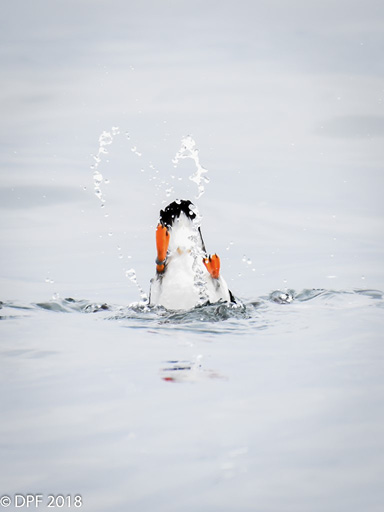Wayne R. Petersen

Don Freiday
Even half a bird is better than no bird, right? With this in mind, readers are challenged with identifying only half a bird, something that is by no means unique to this often-perverse magazine feature. The good news is that this identification is actually relatively easy.
First, there is no doubt that the mystery bird is a diving waterbird species, an attribute that explains why the photograph conveniently depicts only half a bird. It is also obvious in the photograph that the bird has webbed feet, another feature that should not be surprising given that the bird is a diving species.
Even if it is only viewed in black-and-white in the print magazine, other characteristics that are obvious in the picture are that the mystery bird is strikingly white below and, based upon the underside of its stubby tail, seems to be contrastingly black above. This impression is further reinforced by a tiny bit of dark (black?) barely visible on the bird's right wing right at the waterline.
Using only these few clues, it is possible to definitively identify this "half bird." There are few diving birds that are as compact as the pictured individual and that are also pure white below. Most such species are alcids, which further explains the stubby black tail and the suggestion of black wings. The only diving duck likely to appear as white below as the mystery species might be a male Common Merganser. But a merganser of any species would appear longer-tailed and would no doubt appear longer and slimmer overall, not chunky and short-tailed. However, the clincher in this picture becomes obvious if one examines the colored version of the mystery species in Bird Observer Online. It is then abundantly clear that the bird's legs are bright orange—a hallmark feature of the Atlantic Puffin (Fratercula arctica). While it is true that Black Guillemots in nonbreeding plumage are white below, guillemots possess bright red legs and feet, not orange as in the pictured alcid. And finally, it is interesting to note that this puffin has a band on its left leg, no doubt hardware that it obtained on Eastern Egg Rock in the Gulf of Maine close to where the bird was photographed.
The Atlantic Puffin is a rare winter visitor to offshore Massachusetts' waters. Most individuals remain far out at sea unless occasionally driven close to shore at coastal vantage points at Cape Ann or Provincetown by fall and winter nor'easters. They may also sometimes be seen during fall or winter pelagic trips to offshore waters. Don Freiday photographed this Atlantic Puffin off Eastern Egg Rock in the Gulf of Maine on June 7, 2018.
Wayne R. Petersen